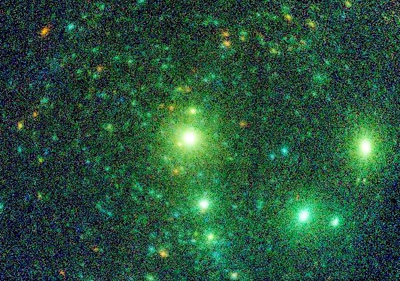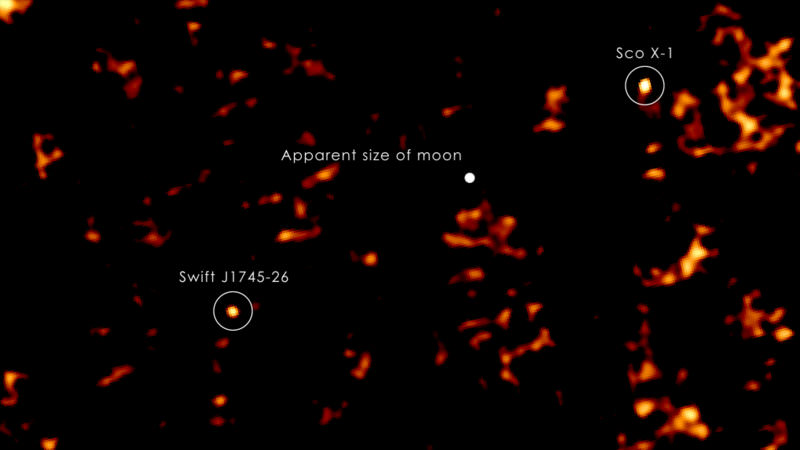Astronomers working with NASA’s Neil Gehrels Swift Observatory have spotted something unusual. The observatory’s X-Ray Telescope (XRT) has captured emissions from a supermassive black hole (SMBH) in a galaxy about 500 million light-years away. The black hole is repeatedly feeding on an unfortunate star that came too close.
Continue reading “A Black Hole Nibbles on a Star Every 22 Days, Slowly Consuming it”Astronomers Track a Neutrino Back to the Source. Where a Black Hole Tore Apart a Star
Neutrinos are notoriously finicky particles. Hundreds of trillions pass through a person’s body every second, yet they hardly seem to interact with anything (though they actually do a lot). Even more hard to find are the “high energy” neutrinos that are believed to be formed as the outcome of some of the most violent events in the universe. Now, researchers using NASA’s Swift telescope have found a high energy neutrino for the first time from one type of those ultra-violent events – a tidal disruption. But something was a little bit off about it.
Continue reading “Astronomers Track a Neutrino Back to the Source. Where a Black Hole Tore Apart a Star”Update: Possible ‘Nearby’ Gamma Ray Burst Alert Was False Alarm

Following the late night news yesterday of a possible gamma ray burst in our next door neighboring galaxy Andromeda, it was an “Oh darn!” moment this morning to find out the big event was likely a false alarm. The false alert — and the ensuing false excitement — was due to an unlikely combination of Swift’s Burst Alert Telescope (BAT) detecting what was a previously known object and a power outage at Goddard Space Flight Center and Swift Data Center, so that the data couldn’t be analyzed by the regular team of astronomers around the world.
Also, according to a blog post by Phil Evans, a post-doctoral research assistant from the University of Leicester and a member of the support team for Swift, the Swift team never actually announced a claim of such an event, and it turns out that the tentative data that triggered this story was overstated.
“Interestingly, the Swift team never claimed it was [a GRB]; indeed, I haven’t seen any professional communication claiming that this was a GRB,” Evans wrote on his blog. “Why it has been reported throughout the web as a GRB is something I can only speculate on, but Swift has been fabulously successful studying GRBs.”
Definitely read Evans’ entire analysis of the event.
A circular posted from the Swift-XRT team” on NASA’s Gamma-ray Coordinates Network (GCN) system at says that the astronomers “do not believe this source to be in outburst”. On the Nature blog, Alexandra Witze spoke with Swift team member Kim Page, also from the University of Leicester, who told Nature “that the source had been initially mistaken for a new outburst, and that its intensity had been overestimated due to measurement error. Instead, she says, it was a relatively common, persistent x-ray source — possibly a globular cluster — that had previously been catalogued.”
Here’s the circular in its entirety:
We have re-analysed the prompt XRT data on Swift trigger 600114 (GCN Circ.
16332), taking advantage of the event data.The initial count rate given in GCN Circ. 16332 was based on raw data from
the full field of view, without X-ray event detection, and therefore may
have been affected by other sources in M31, as well as background hot
pixels. Analysis of the event data (not fully available at the time of the
initial circular) shows the count rate of the X-ray source identified in
GCN Circ. 16332 to have been 0.065 +/- 0.012 count s^-1, consistent with
the previous observations of this source [see the 1SXPS catalogue (Evans
et al. 2014): http://www.swift.ac.uk/1SXPS/1SXPS%20J004143.1%2B413420].We therefore do not believe this source to be in outburst. Instead, it was
a serendipitous constant source in the field of view of a BAT subthreshold
trigger.This circular is an official product of the Swift-XRT team.
The event caused a tweet-storm last night on Twitter (see #GRBM31) and as many have said, the excitement was magnified because of the ability to spread news quickly via social media:
The dangers of instant science: #GRBM31 was a false alarm. http://t.co/RGXPpJ4bZF @Summer_Ash @mikamckinnon
— Jonathan McDowell (@planet4589) May 28, 2014
Astronomer Robert Rutledge, who publishes the Astronomer’s Telegram has given a Tweet-by-Tweet analysis of what happened with the false alarm:
(8/15) The science 'Chain of Evidence' means, wrong analysis produces wrong numbers produces wrong conclusions #GRBm31 #doesnotexist
— Robert Rutledge (@rerutled) May 28, 2014
(9/15) So: Wrong X-ray brightness -> wrong conclusion abt nature of source = No GRB = No ULX. #GRBM31 #DoesNotExist
— Robert Rutledge (@rerutled) May 28, 2014
(10/15) You may ask: How could @NASASwift scientists get the brightness wrong of #GRBm31 by a factor of 300? #DoesNotExist
— Robert Rutledge (@rerutled) May 28, 2014
(11/15) First, @NASASwift scientists are among the best in the world. Top rated by NASA in the recent Senior Review! #GRBM31 #DoesNotExist
— Robert Rutledge (@rerutled) May 28, 2014
(12/15) Here, they probably relied on analysis programs which NORMALLY work. But, the programs 'glitched' #GRBM31 #DoesNotExist
— Robert Rutledge (@rerutled) May 28, 2014
(13/15) Usu. other scientists would get the data and look too! BUT last night, a storm took out @NASAGoddard Internet #GRBM31 #DoesNotExist
— Robert Rutledge (@rerutled) May 28, 2014
(14/15) With @NASAGoddard internet disrupted nobody else could analyse the #GRBM31 Data! We all relied on the @NASASwift GCN #DoesNotExist
— Robert Rutledge (@rerutled) May 28, 2014
(15/15) Analysis mistake->wrong result+ @NASAGoddard Internet down->no 'second eyes' to double check->wrong conclusion #GRBm31 #DoesNotExist
— Robert Rutledge (@rerutled) May 28, 2014
Possible Gamma Ray Burst Detected in Andromeda, Would be Closest Ever Observed
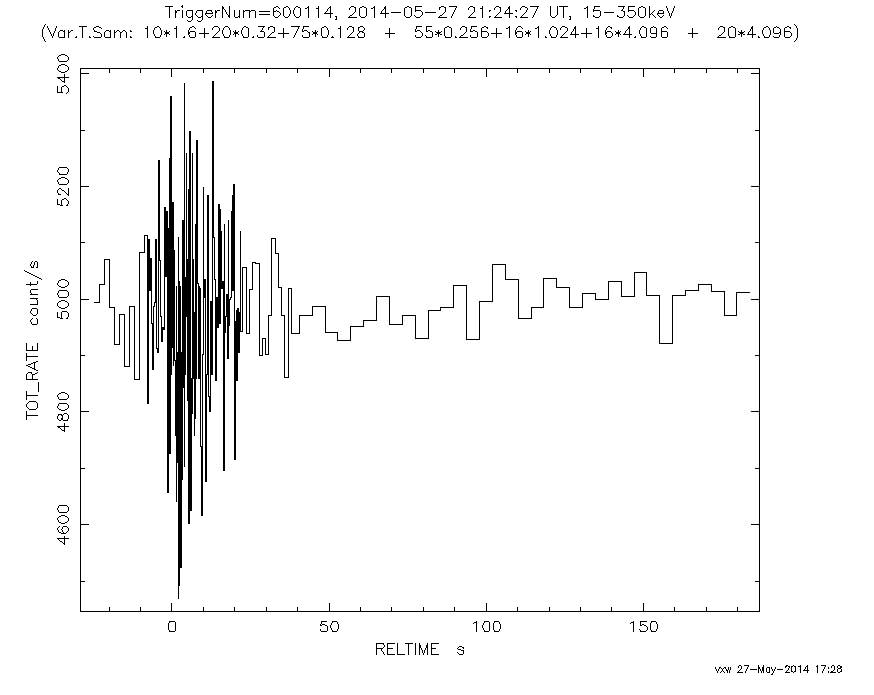
Update (5/28/14 9:20 am EDT): This alert may have been a false alarm. Further analysis showed the initial brightness was overestimated by a factor of 300. An official circular from the Swift-XRT team says “therefore do not believe this source to be in outburst. Instead, it was a serendipitous constant source in the field of view of a BAT subthreshold trigger.” Please read our subsequent article here that provides further information and analysis.
Something went boom in the Andromeda Galaxy, our next door neighbor. The Swift Gamma-Ray Burst telescope detected a sudden bright emission of gamma rays. Astronomers aren’t sure yet if it was a Gamma-Ray Burst (GRB) or an Ultraluminous X-Ray (ULX) or even an outburst from a low-mass x-ray binary (LMXB), but whatever it turns out to be, it will be the closest event of this kind that we’ve ever observed.
One of the previous closest GRBs was 2.6 billion light-years away, while Andromeda is a mere 2.5 million light years away from Earth. Even though this would be the closest burst to Earth, there is no danger of our planet getting fried by gamma rays.
According to astronomer (Bad Astronomer!) Phil Plait, a GRB would have to be less than 8,000 light years away cause any problems for us.
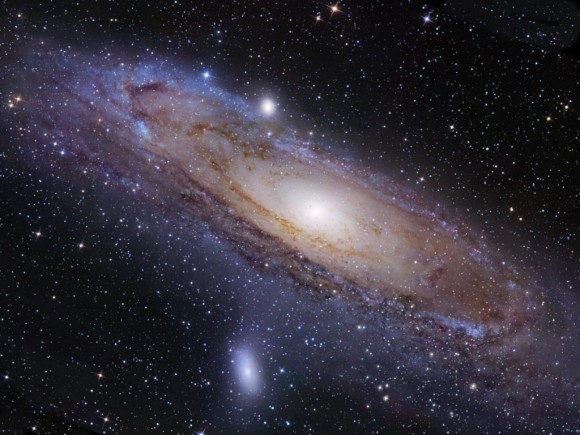
This event is providing astronomers with a rare opportunity to gain information vital to understanding powerful cosmic explosions like this.
If it is a GRB, it likely came from a collision of neutron stars. If it is a ULX, the blast came from a black hole consuming gas. If the outburst was from a LMXB, a black hole or neutron star annihilated its companion star.
Astronomers should be able to determine the pedigree of this blast within 24-48 hours by watching the way the light fades from the burst.
How this Blast was Detected
The Swift Burst Alert telescope watches the sky for gamma-ray bursts and, within seconds of detecting a burst Swift relays the location of the burst to ground stations, allowing both ground-based and space-based telescopes around the world the opportunity to observe the burst’s afterglow. As soon as it can, Swift will swiftly shift itself to observe the burst with its X-ray and ultraviolet telescopes.
The burst alert came at 21:21 pm Universal time on May 27, 2014; three minutes later, the X-ray telescope aboard Swift was observing a bright X-ray glow.
News of the event quickly spread across the astronomical community and on Twitter, sending astronomers scrambling for their telescopes.
Remember scene in Contact where they got a weird signal & called up astronomers all over the world to look? That happens for GRBs. #GRBm31
— Katie Mack (@AstroKatie) May 27, 2014
According to astronomer Katie Mack on Twitter, if this is indeed a GRB, this gamma-ray burst looks like a short GRB.
No two GRBs are the same, but they are usually classified as either long or short depending on the burst’s duration. Long bursts are more common and last for between 2 seconds and several minutes; short bursts last less than 2 seconds, meaning the action can all be over in just milliseconds.
As we noted earlier, more should be known about this blast within a day or so and we’ll keep you posted. In the meantime, you can follow the hashtag #GRBM31 on Twitter to see the latest. Katie Mack or Robert Rutledge (Astronomer’s Telegram) have been tweeting pertinent info about the burst.
Our Galactic Neighbors Shine In New Ultraviolet Pictures
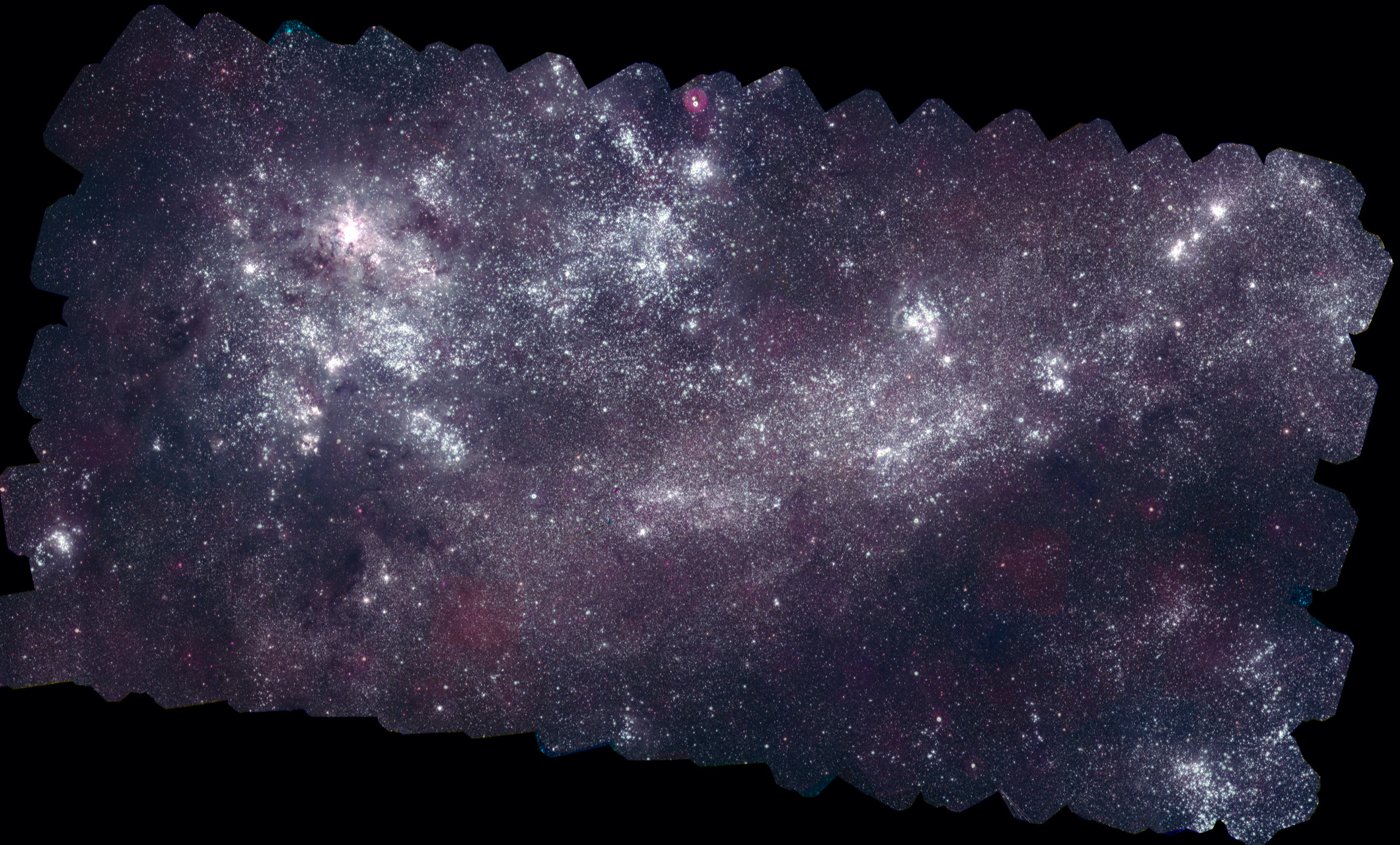
Earth’s galactic next-door neighbors shine brighter than ever in new pictures taken by an orbiting telescope, focusing on ultraviolet light that is tricky to image from the surface.
The Large Magellanic Cloud (LMC) and Small Magellanic Cloud (SMC) — the two largest major galaxies near our own, the Milky Way — were imaged in 5.4 days and 1.8 days of cumulative exposure time, respectively. These produced two gorgeous, high-resolution photos in a spot of the light spectrum normally invisible to humans.
“Prior to these images, there were relatively few UV observations of these galaxies, and none at high resolution across such wide areas, so this project fills in a major missing piece of the scientific puzzle,” stated Michael Siegel, lead scientist for Swift’s Ultraviolet/Optical Telescope at the Swift Mission Operations Center at Pennsylvania State University.
Science isn’t interested in these pictures — taken in wavelengths ranging from 1,600 to 3,300 angstroms, mostly blocked in Earth’s atmosphere — because of their pretty face, however. Ultraviolet light pictures let the hottest stars and star-forming areas shine out, while in visible light those hotspots are suppressed.
“With these mosaics, we can study how stars are born and evolve across each galaxy in a single view, something that’s very difficult to accomplish for our own galaxy because of our location inside it,” stated Stefan Immler, an associate research scientist at NASA Goddard Space Flight Center and the lead of the SWIFT guest investigator program.
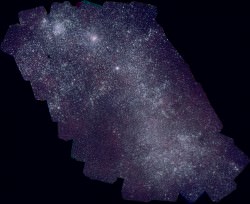
Although the galaxies are relatively small, they easily shine in our night sky because they’re so close to Earth — 163,000 light-years for the LMC, and 200,000 light years for the SMC.
The LMC is only about 1/10 of the Milky Way’s size, with 1% of the Milky Way’s mass. The punier SMC is half of LMC’s size with only two-thirds of that galaxy’s mass.
Immler revealed the large images — 160 megapixels for the LMC, and 57 megapixels for the SMC — at the American Astronomical Society meeting in Indianapolis on Monday (June 3.)
Source: NASA
How Much Light Has The Universe Created Since the Big Bang?
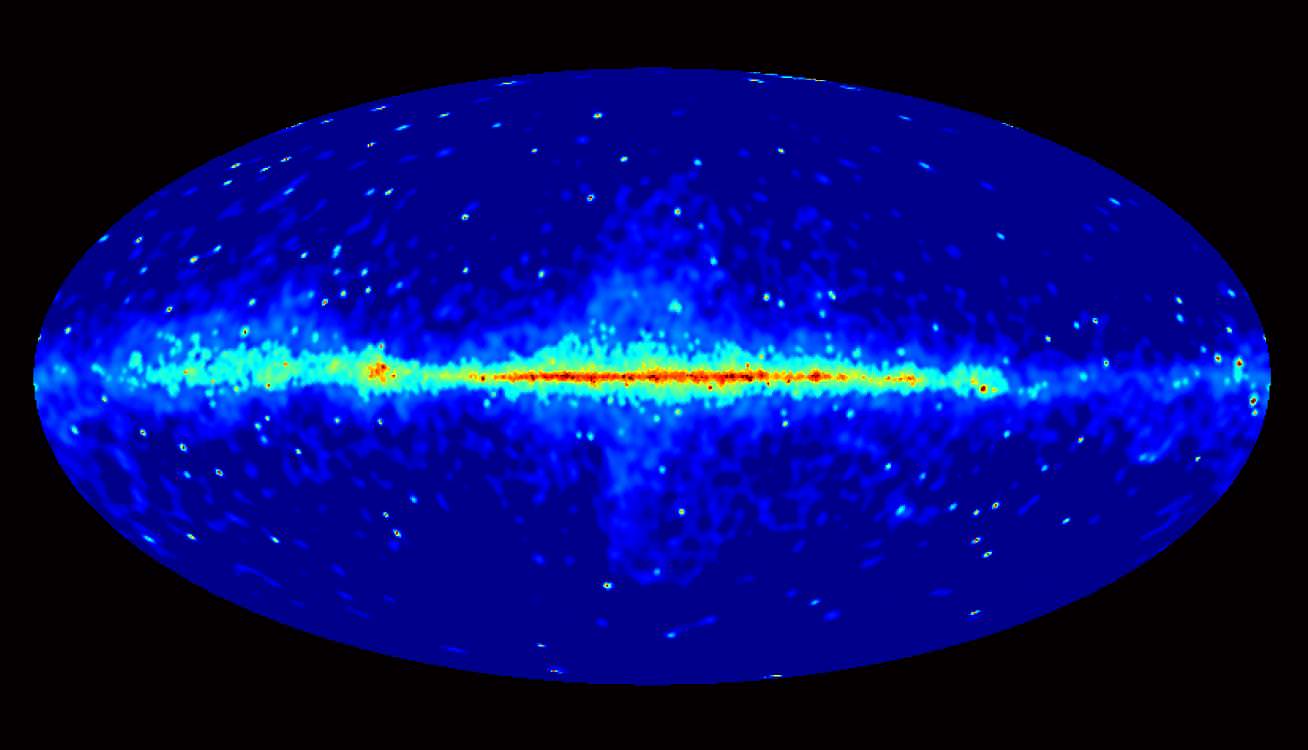
The universe, most cosmologists tell us, began with a bang. At some point, the lights turned on. How much light has the universe produced since it was born, 13.8 billion years ago?
It seems a difficult answer at first glance. Turn on a light bulb, turn it off and the photons appear to vanish. In space, however, we can track them down. Every light particle ever radiated by galaxies and stars is still travelling, which is why we can peer so far back in time with our telescopes.
A new paper in the Astrophysical Journal explores the nature of this extragalactic background light, or EBL. Measuring the EBL, the team states, “is as fundamental to cosmology as measuring the heat radiation left over from the Big Bang (the cosmic microwave background) at radio wavelengths.”
Turns out that several NASA spacecraft have helped us understand the answer. They peered at the universe in every wavelength of light, ranging from long radio waves to short, energy-filled gamma rays. While their work doesn’t go back to the origin of the universe, it does give good measurements for the last five billion years or so. (About the age of the solar system, coincidentally.)
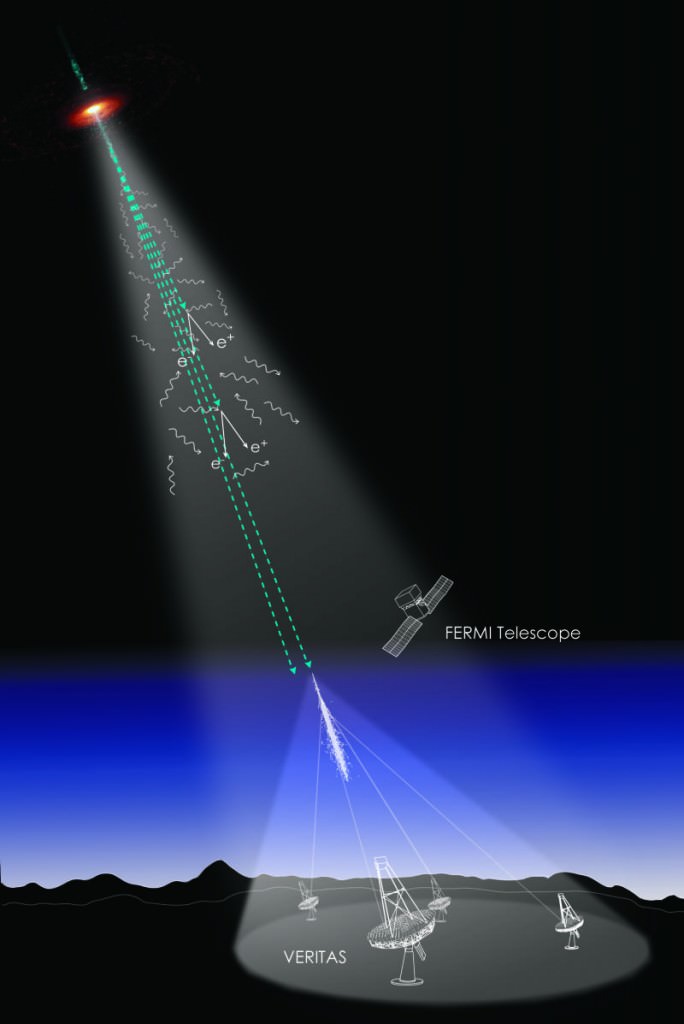
It’s hard to see this faint background light against the powerful glow of stars and galaxies today, about as hard as it is to see the Milky Way from downtown Manhattan, the astronomers said.
The solution involves gamma rays and blazars, which are huge black holes in the heart of a galaxy that produce jets of material that point towards Earth. Just like a flashlight.
These blazars emit gamma rays, but not all of them reach Earth. Some, astronomers said, “strike a hapless EBL photon along the way.”
When this happens, the gamma ray and photon each zap out and produce a negatively charged electron and a positively charged positron.
More interestingly, blazars produce gamma rays at slightly different energies, which are in turn stopped by EBL photons at different energies themselves.
So, by figuring out how many gamma rays with different energies are stopped by the photons, we can see how many EBL photons are between us and the distant blazars.
Scientists have now just announced they could see how the EBL changed over time. Peering further back in the universe, as we said earlier, serves as a sort of time machine. So, the further back we see the gamma rays zap out, the better we can map out the EBL’s changes in earlier eras.

To get technical, this is how the astronomers did it:
– Compared the gamma-ray findings of the Fermi Gamma-ray Space Telescope to the intensity of X-rays measured by several X-ray observatories, including the Chandra X-Ray Observatory, the Swift Gamma-Ray Burst Mission, the Rossi X-ray Timing Explorer, and XMM/Newton. This let astronomers figure out what the blazars’ brightnesses were at different energies.
– Comparing those measurements to those taken by special telscopes on the ground that can look at the actual “gamma-ray flux” Earth receives from those blazars. (Gamma rays are annihilated in our atmosphere and produce a shower of subatomic particles, sort of like a “sonic boom”, called Cherenkov radiation.)
The measurements we have in this paper are about as far back as we can see right now, the astronomers added.
“Five billion years ago is the maximum distance we are able to probe with our current technology,” stated the paper’s lead author, Alberto Dominguez.
“Sure, there are blazars farther away, but we are not able to detect them because the high-energy gamma rays they are emitting are too attenuated by EBL when they get to us—so weakened that our instruments are not sensitive enough to detect them.”
Source: University of California High-Performance AstroComputing Center
Bright, Long-Lasting GRB Sets Energy Output Record
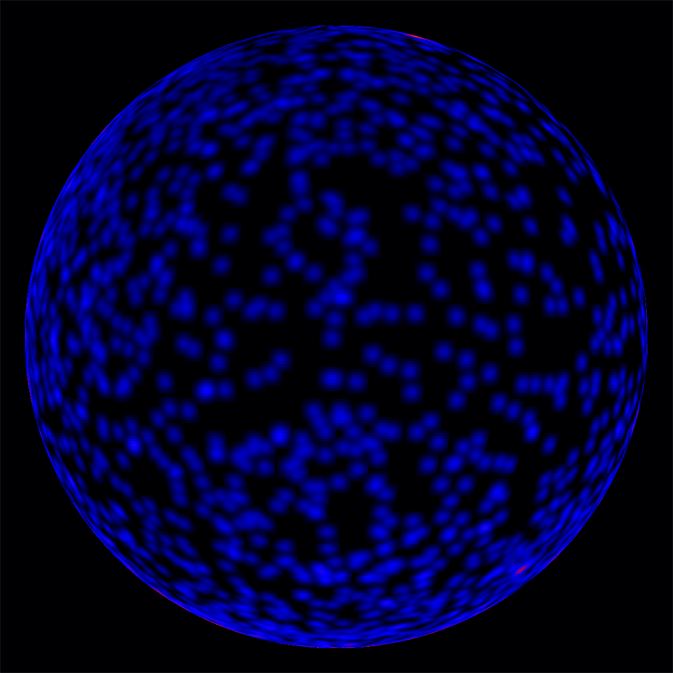
Last weekend (April 27, 2013), the Fermi and Swift spacecraft witnessed a “shockingly” bright burst of gamma rays from a dying star. Named GRB 130427A, it produced one of the longest lasting and brightest GRBs ever detected.
Because Swift was able to rapidly determine the GRB’s position in the sky, and also because of the duration and brightness of the burst, the GRB was able to be detected in optical, infrared and radio wavelengths by ground-based observatories. Astronomers quickly learned that the GRB had one other near-record breaking quality: it was relatively close, as it took place just 3.6 billion light-years away.
“This GRB is in the closest 5 percent of bursts, so the big push now is to find an emerging supernova, which accompanies nearly all long GRBs at this distance,” said Neil Gehrels, principal investigator for Swift.
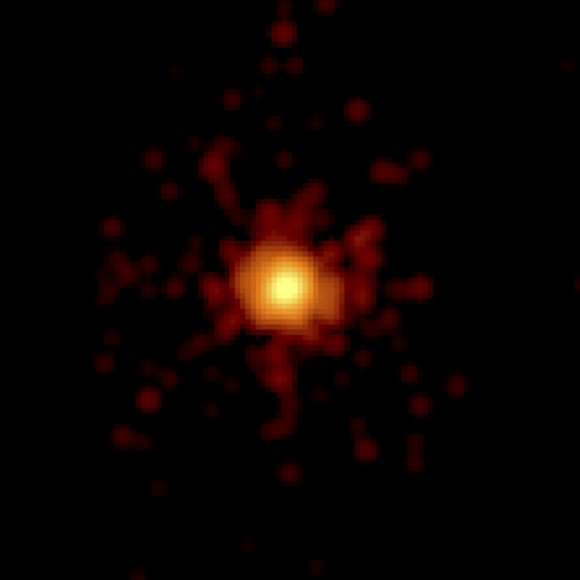
Credit: NASA/Swift/Stefan Immler.
“We have waited a long time for a gamma-ray burst this shockingly, eye-wateringly bright,” said Julie McEnery, project scientist for the Fermi Gamma-ray Space Telescope. “The GRB lasted so long that a record number of telescopes on the ground were able to catch it while space-based observations were still ongoing.”
No two GRBs are the same, but they are usually classified as either long or short depending on the burst’s duration. Long bursts are more common and last for between 2 seconds and several minutes; short bursts last less than 2 seconds, meaning the action can all over in only milliseconds.
This recent event started just after 3:47 a.m. EDT on April 27. Fermi’s Gamma-ray Burst Monitor (GBM) triggered on the eruption of high-energy light in the constellation Leo. The burst occurred as NASA’s Swift satellite was slewing between targets, which delayed its Burst Alert Telescope’s detection by a few seconds.
Fermi’s Large Area Telescope (LAT) recorded one gamma ray with an energy of at least 94 billion electron volts (GeV), or some 35 billion times the energy of visible light, and about three times greater than the LAT’s previous record. The GeV emission from the burst lasted for hours, and it remained detectable by the LAT for the better part of a day, setting a new record for the longest gamma-ray emission from a GRB.
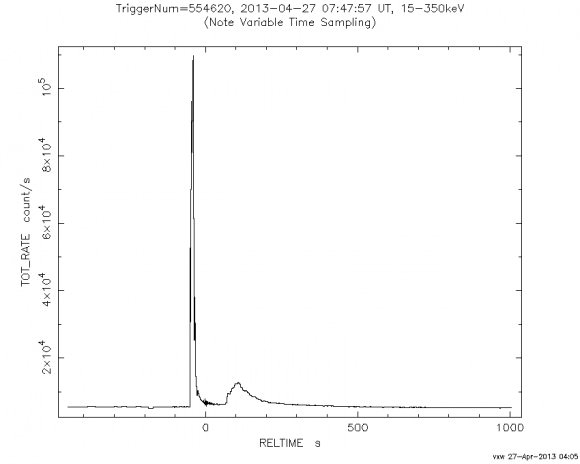
As far as the optical brightness of this event, according to a note posted on the BAUT Forum (the Universe Today and Bad Astronomy forum) data from the SARA-North 1-meter telescope at at Kitt Peak in Arizona at about 04:00 UT on April 29 showed a relative magnitude of about 18.5.
Gamma-ray bursts are the universe’s most luminous explosions, and come from the explosion of massive stars or the collision between two pulsars. Colliding pulsars are usually of short duration, so astronomers can rule out a pulsar collision as causing this event.
If the GRB is near enough, astronomers usually discover a supernova at the site a week or so after the outburst.
NASA said that ground-based observatories are monitoring the location of GRB 130427A and expect to find an underlying supernova by midmonth.
What Happens When the Winds of Giant Stars Collide?
XMM-Newton observation of the core of the very massive cluster Cyg OB2 located in the constellation of Cygnus, 4700 light-years from Earth. Credit: ESA/G. Rauw
Two massive stars racing in orbit around each other have had their colliding stellar winds X-rayed for the first time, thanks to the combined efforts of ESA’s XMM-Newton and NASA’s Swift space telescopes. Stellar winds, pushed away from a massive star’s surface by its intense light, can have a profound influence on their environment. In some locations, they may trigger the collapse of surrounding clouds of gas and dust to form new stars. In others, they may blast the clouds away before they have the chance to get started.
Now, XMM-Newton and Swift have found a ‘Rosetta stone’ for such winds in a binary system known as Cyg OB2 #9, located in the Cygnus star-forming region, where the winds from two massive stars orbiting around each other collide at high speeds.
Cyg OB2 #9 remained a puzzle for many years. Its peculiar radio emission could only be explained if the object was not a single star but two, a hypothesis that was confirmed in 2008. At the time of the discovery, however, there was no direct evidence for the winds from the two stars colliding, even though the X-ray signature of such a phenomenon was expected.
This signature could only be found by tracking the stars as they neared the closest point on their 2.4-year orbit around each other, an opportunity that presented itself between June and July 2011.
As the space telescopes looked on, the fierce stellar winds slammed together at speeds of several million kilometres per hour, generating hot plasma at a million degrees which then shone brightly in X-rays.
The telescopes recorded a four-fold increase in energy compared with the normal X-ray emission seen when the stars were further apart on their elliptical orbit.
“This is the first time that we have found clear evidence for colliding winds in this system,” says Yael Nazé of the Université de Liège, Belgium, and lead author of the paper describing the results reported in Astronomy & Astrophysics.
“We only have a few other examples of winds in binary systems crashing together, but this one example can really be considered an archetype for this phenomenon.”
Unlike the handful of other colliding wind systems, the style of the collision in Cyg OB2 #9 remains the same throughout the stars’ orbit, despite the increase in intensity as the two winds meet.
“In other examples the collision is turbulent; the winds of one star might crash onto the other when they are at their closest, causing a sudden drop in X-ray emission,” says Dr Nazé.
“But in the Cyg OB2 #9 system there is no such observation, so we can consider it the first ‘simple’ example that has been discovered – that really is the key to developing better models to help understand the characteristics of these powerful stellar winds. ”
“This particular binary system represents an important stepping stone in our understanding of stellar wind collisions and their associated emissions, and could only be achieved by tracking the two stars orbiting around each other with X-ray telescopes,” adds ESA’s XMM-Newton project scientist Norbert Schartel.
Read the team’s paper: The 2.35 year itch of Cyg OB2 #9 – I. Optical and X-ray monitoring
Rare X-Ray Nova Reveals a New Black Hole in the Milky Way
Swift J1745-26, with a scale of the moon as it would appear in the field of view from Earth. This image is from September 18, 2012 when the source peaked in hard X-rays. Credit: NASA/Goddard Space Flight Center/S. Immler and H. Krimm
Back in mid-September, the Swift satellite was going about its multi-wavelength business of watching for bursts of bright gamma-ray, X-ray, ultraviolet, or optical events in the sky, when it detected a rising tide of high-energy X-rays from a source toward the center of our Milky Way galaxy. But this was different from any other burst the satellite had detected, and after observing the event for a few days, astronomers knew this had to be a rare X-ray nova. What it meant was that Swift had detected the presence of a previously unknown stellar-mass black hole.
“Bright X-ray novae are so rare that they’re essentially once-a-mission events and this is the first one Swift has seen,” said Neil Gehrels from Goddard Space Flight Center, the mission’s principal investigator. “This is really something we’ve been waiting for.”
The object was named Swift J1745-26 after the coordinates of its sky position, the nova is located a few degrees from the center of our galaxy toward the constellation Sagittarius. While astronomers do not know its precise distance, they think the object resides about 20,000 to 30,000 light-years away in the galaxy’s inner region.
An X-ray nova is a short-lived X-ray source that appears suddenly in the sky and dramatically increases in strength over a period of a few days and then decreases, fading out over a few months. Unlike a conventional nova, where the compact component is a white dwarf, an X-ray nova is caused by material – usually gas — falling onto a neutron star or a black hole.
The rapidly brightening source triggered Swift’s Burst Alert Telescope twice on the morning of Sept. 16, and once again the next day.
Ground-based observatories detected infrared and radio emissions, but thick clouds of obscuring dust have prevented astronomers from catching Swift J1745-26 in visible light.
The nova peaked in hard X-rays — energies above 10,000 electron volts, or several thousand times that of visible light — on Sept. 18, when it reached an intensity equivalent to that of the famous Crab Nebula, a supernova remnant that serves as a calibration target for high-energy observatories and is considered one of the brightest sources beyond the solar system at these energies.
Even as it dimmed at higher energies, the nova brightened in the lower-energy, or softer, emissions detected by Swift’s X-ray Telescope, a behavior typical of X-ray novae. By Wednesday, Swift J1745-26 was 30 times brighter in soft X-rays than when it was discovered and it continued to brighten.
“The pattern we’re seeing is observed in X-ray novae where the central object is a black hole. Once the X-rays fade away, we hope to measure its mass and confirm its black hole status,” said Boris Sbarufatti, an astrophysicist at Brera Observatory in Milan, Italy, who currently is working with other Swift team members at Penn State in University Park, Pa.
Here’s usually happens in events like this: The black hole is part of a binary system with a normal Sun-like star. A stream of material flows into an accretion disk around the black hole. Usually, the disk of gas spirals in steadily to the black hole, heats up and produces a steady X-ray glow. But sometimes, for reasons unknown, the material is held up in the outer regions, held back by some mechanism, almost like a dam. Once enough gas accumulates, the dam breaks and a flood of gas surges towards the black hole, creating the X-ray nova outburst.
“Each outburst clears out the inner disk, and with little or no matter falling toward the black hole, the system ceases to be a bright source of X-rays,” said John Cannizzo, a Goddard astrophysicist. “Decades later, after enough gas has accumulated in the outer disk, it switches again to its hot state and sends a deluge of gas toward the black hole, resulting in a new X-ray outburst.”
This phenomenon, called the thermal-viscous limit cycle, helps astronomers explain transient outbursts across a wide range of systems, from protoplanetary disks around young stars, to dwarf novae — where the central object is a white dwarf star — and even bright emission from supermassive black holes in the hearts of distant galaxies.
It is estimated that our galaxy must harbor some 100 million stellar-mass black holes. Most of these are invisible to us, and only about a dozen have been identified.
Swift discovers about 100 bursts per year. The Burst Alert Telescope detects GRBs and other events and accurately determines their positions on the sky. Swift then relays a 3 arcminute position estimate to the ground within 20 seconds of the initial detection, enabling ground-based observatories and other space observatories the chance to observe the event as well. The Swift spacecraft itself “swiftly” –in less than approximately 90 seconds — and autonomously repoints itself to bring the burst location within the field of view of the sensitive narrow-field X-ray and UV/optical telescopes to observe the afterglow and gather data.
Source: NASA
Swift Satellite Captures Asteroid 2005 YU55’s Tumbling Flyby
If you want to photograph something in space, what better way than to have a spacecraft take the picture? The Swift Telescope – better known for its study of high-energy outbursts and cosmic explosions – was able to observe the flyby of 2005 YU55, the asteroid that came within 324,600 kilometers (201,700 miles) of Earth this week, and captured its tumbling, rapid motion across the sky.
“Swift’s ultraviolet and X-ray capability gives scientists a unique perspective on comets and asteroids, expanding the spectral window beyond the radio, infrared and optical observations so well handled by big ground-based facilities,” said Sergio Campana, a Swift team member at Brera Observatory in Merate, Italy.” Campana requested that the spacecraft train its telescopes on the asteroid as a target of opportunity.
Continue reading “Swift Satellite Captures Asteroid 2005 YU55’s Tumbling Flyby”



